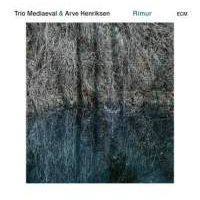Home » Jazz Articles » Album Review » Trio Mediaeval & Arve Henriksen: Rímur
Trio Mediaeval & Arve Henriksen: Rímur
The source music in this collection began as either monophony (single voice) or two-voice polyphony. As Anna Maria Friman points out in her liner notes, polyphony was rarely heard until late in the medieval period: multi-voice polyphony became one of the defining features of Renaissance music, culminating in works like Thomas Tallis' 40-part motet "Spem in alium." So, in the historical context, even two-voice compositions would have made a special impression. Much of the Trio's improvisation may have involved the creation of three-part vocal harmonies for music created for one or two voices. Henriksen's role is more obviously improvisational—taking an obbligato role—but as the collective developed many of these arrangements together, it seems clear that he is not just winging it.
Opener "St. Birgitta Hymn—Rosa rorans bonitatem" (the only piece here with a known composer, Nils Hermansson) presents the three vocalists singing the hymn, then vocalizing behind Henriksen's distinctive, reedy trumpet. It's a sound that seems perfectly matched to the human voice, as if this was always the setting it was destined for. "O Jesu ducissime" (from the Icelandic Tvísöngur C17 collection, also the source of some other selections) features Friman's Hardanger fiddle playing in an active role, far more than just a simple drone. Linn Andrea Fuglseth also plays the shruti box on some pieces, a simple reed organ with a bellows that has traditionally been used as a drone instrument in classical Indian raga performance.
"Krummi" is the only track without a traditional basis: it's credited to Friman and Henriksen. There are multiple voices, but the sound fits right in with the rest of the program. "Du är den första" (a traditional Swedish shanty) again features the fiddle, along with a trumpet solo. I believe this is the only selection with trumpet where Henriksen does not get co-arranger credit.
The album ends with the lovely pure sound of the trio singing a cappella on the chant "Alma Redemptoris Mater," followed by three folk songs: "Bíum bíum bambaló" (from Iceland); "Jag haver ingen kärare" (from Sweden); and "Gammelkjerringvalsen" (from Norway). A beautiful ending to an exceptionally lovely collection of music, even by ECM standards.
Track Listing
St Birgitta Hymn – Rosa rorans bonitatem; O Jesu dulcissime; Om ödet skulle skicka mig; Morgunstjarna; Rís upp, drottni dyrð; St Magbnus Hymn – Nobilis humilis; Lata gjálla létt og hátt; Brureslått; St Sunniva Hymn – Eterna Christi munera; Krummi; Anda þinn guð mér gef þú vist ; Sulla lulla; Du är den första; Alma Rerdemptoris; Bíum bíum bambaló; Ja haver ingen kärare; Gammelkjerrringsvalsen.
Personnel
Trio Mediaeval
band / ensemble / orchestraAnna Maria Friman: voice, Hardanger Fiddle; Linn Andrea Fuglseth: voice, Shruti Box; Berit Opheim: voice; Arve Henriksen: Trumpet, electronics.
Album information
Title: Rímur | Year Released: 2017 | Record Label: ECM Records
< Previous
Conversations
Comments
About Trio Mediaeval
Instrument: Band / ensemble / orchestra
Related Articles | Concerts | Albums | Photos | Similar ToTags
For the Love of Jazz
 All About Jazz has been a pillar of jazz since 1995, championing it as an art form and, more importantly, supporting the musicians who create it. Our enduring commitment has made "AAJ" one of the most culturally important websites of its kind, read by hundreds of thousands of fans, musicians and industry figures every month.
All About Jazz has been a pillar of jazz since 1995, championing it as an art form and, more importantly, supporting the musicians who create it. Our enduring commitment has made "AAJ" one of the most culturally important websites of its kind, read by hundreds of thousands of fans, musicians and industry figures every month.




















